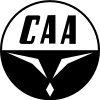Central African Airways
 |
|||||||
|
|||||||
| Founded | 1946 | ||||||
|---|---|---|---|---|---|---|---|
| Ceased operations | 1967 (split up into Zambia Airways, Air Malawi and Air Rhodesia) |
||||||
| Hubs | Belvedere Airport (1946–1956) Salisbury Airport (1956–1967) |
||||||
| Focus cities | Lusaka Airport Ndola Airport |
||||||
| Headquarters | Salisbury, Southern Rhodesia | ||||||
| Key people | Charles Warburton Meredith Ellis Robins |
||||||
Central African Airways (CAA) was a supranational airline corporation serving as flag carrier for Southern Rhodesia, Northern Rhodesia and Nyasaland (present day Zimbabwe, Zambia and Malawi), which were organised as Federation of Rhodesia and Nyasaland from 1953 to 1963. Based in Salisbury, it offered an extensive network of domestic passenger and cargo flights, as well as international services to major cities in Southern and Central Africa, and a route to London. In 1960, CAA owned 15 aircraft and had 1155 employees.
Prior to World War II, commercial flights in Southern Rhodesia were offered by Southern Rhodesia Air Services (SRAS), whilst Northern Rhodesia and Nyasaland had a joined airline company called Rhodesia and Nyasaland Airways (RANA). In 1946, it was decided to consolidate the airline operations of the three territories into one corporation, thus creating Central African Airways.Charles Warburton Meredith served as founding chairman, overseeing an initial fleet of fifteen de Havilland Dragon Rapide, five Avro Anson, one de Havilland Tiger Moth and one de Havilland Leopard Moth, all of which had previously been operated by the respective air forces. Originally, the airline was headquartered at Belvedere Airport (serving Salisbury, now demolished). Between 1948 and 1949, two Bristol Freighters joined the fleet.
To get larger and more modern aircraft, CAA purchased three Vickers VC.1 Viking and five de Havilland Dove, the first of which were delivered in 1947. The Vikings formed the backbone for mainline passenger flights until their withdrawal from service in 1958, most notably (since 1953) the "Colonial Coach Service", linking Salisbury, Ndola and Lusaka with London. The Doves were intended to be used for so called bush flights to poorly prepared landing strips, but proved unsuitable for the prevailing hot and high conditions. Therefore, from 1951 onwards, they were replaced by de Havilland Beavers, which had the desired STOL capabilities.
...
Wikipedia
